[As originally posted on http://sassybot.com/blog/the-characters-of-fragments-of-him/]
Fragments of Him has now finally been released on Steam and Xbox after about 3 years after the prototype that started this all saw the light of day. During all this development we have not taken the time to talk about how the characters came to be
This blog is the first in a two-part series that will talk about how the characters in Fragments of Him took shape and were given life. In the next blog I want to tell you more about the processes we tried, and which we finally used, to create the character poses and animations to tell the story.
Our goal was to tell a compelling story that we could bring to market, and we knew from the beginning that this would be a challenge with a core team of three and limited resources. While I am not an expert on character development or motion capture, we had to deal with both to tell the story that we felt needed to be told. These constraints drove many of our decisions moving forward.
How it began
Several years ago Fragments of Him saw the light of day after a 3 day game jam. It became a short story with crude environments and a single faceless static character pushed into poses with single solid hues to indicate different characters.
 Fragments of Him Prototype (2013)
Fragments of Him Prototype (2013)
Considering the time limitation during which this prototype was made, I think that we did a decent job in conveying a story using abstract characters in simple poses. It has moved many players to tears both online and at conferences around the world. If you haven't played it yet and have a browser that still supports the old Unity Web Player then you can play the 15 minutes story here.
Pre-production considerations
When we talked about taking Fragments of Him to the next level, one of the challenges we faced was evolving the characters and their representation. As the environments became more detailed, so did the characters.
It was important for us to stay out of what is known as the Uncanny Valley. In a nut-shell, creating realistic and believable characters is incredibly hard. If not done right you run the risk of characters that don’t look quite right and appear more creepy than likeable. Lacking the resources to tackle this issue, we chose to avoid it by giving our characters an appearance that lies between face and faceless.
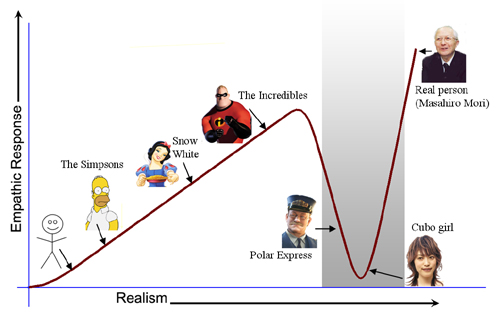
The Uncanny Valley - Source: http://filmescape.com/what-is-the-uncanny-valley
Our core team did not have a lot of experience with character development, rigging, or animation and we were fortunate to have been able to work together with talent that enabled us to dive into this area.
The process
As with the prototype, the core experience relies heavily on its narrative. For us, this meant that while the story's writer, Mata Haggis, was shaping the story and its characters he was also continuously providing us with biographies, descriptions, and image references to help us start the journey to creating the 3D models of the cast.
With the script taking shape we realised that certain locations and story points needed more characters than we had the capacity to produce. We took different approaches for the main cast and what we call the 'filler characters'. First we will look at the main cast consisting of Will, Sarah, Mary and Harry. After that we will take a brief look at the choices and development of the filler characters.
The main cast
We needed to begin shaping how our cast would look. Starting from the information and references that Mata provided us with, the next step was to create thumbnails for each of the characters.
These thumbnails gave us a good impression on the readability of each character and it gave us a lot to talk and think about before even opening 3D modelling software. Silhouettes, contrast and highlights already tell us a lot about these figures.

Clothing and figure concepts for Will and Harry
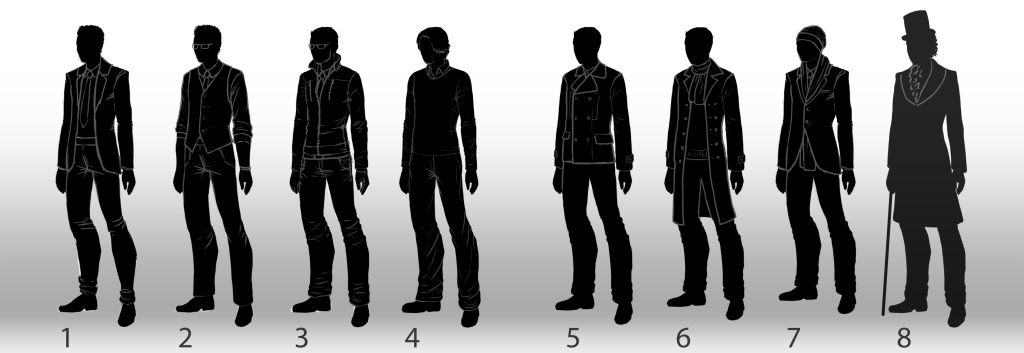
Clothing and figure concepts for Will and Harry
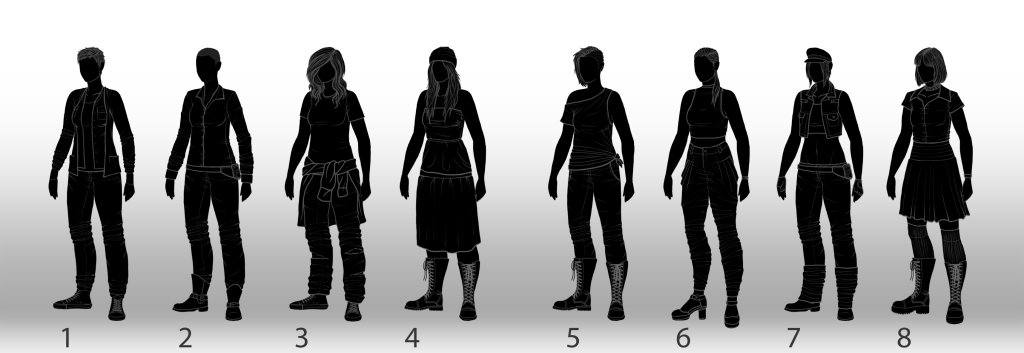
Clothing and figure concepts for Sarah

Clothing and figure concepts for Mary
If none of the thumbnails got close to Mata’s vision of the cast we would have to keep creating thumbnails until we get to a design that fits the story. The next step in the process is to add more detail and steer the character’s development along the way. We had many meetings with Mata to get iterative feedback, making sure that the details were matching the people, their tastes, and the year that each scene was set in.
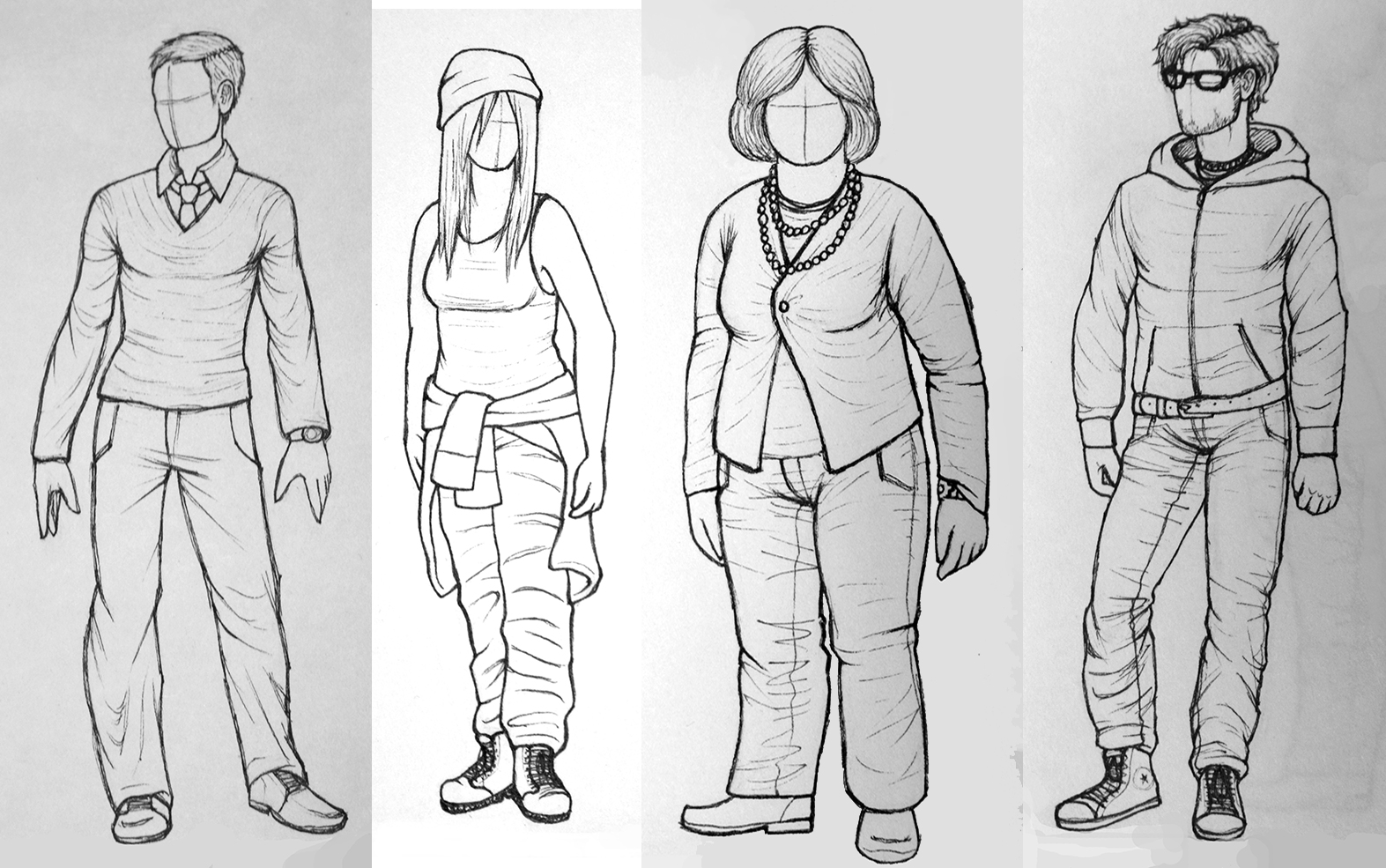 Harry, Sarah, Mary, Will
Harry, Sarah, Mary, Will
Facing the concerns
Before moving on with talking about the general development of the characters I would like to explain more about our decision for the character's faces. When we created the prototype we were very concerned about how players were going to relate to the characters in the story and despite using the same character model with only a single colour differentiating one character from another, it didn’t seem to matter for the delivery of the story. More interestingly, players mentioned that they related to these characters in ways we could not foresee.
“I recently lost my father, different way but same impact. This actually helped me let out my feelings. It brought back memories and helped me realize how much he did for me and cared for me. I miss him so much. 5/5”
Comments like this gave us the notion that we could tell a good story while leaving the faces impressionable enough for players to project their experiences onto the cast. Furthermore, while we would love to dive into the interesting challenge that is face design, modelling, rigging, and animation, we knew that it would take far more time and resources than we had available.
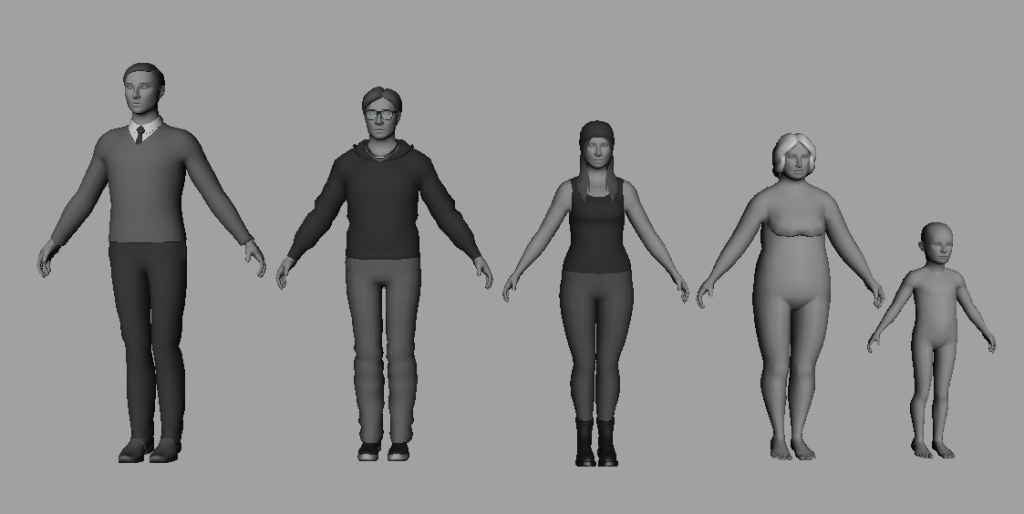
Character progress shot
Knowing that the limitations of a small studio meant we couldn't do detailed faces, we were still exploring how we would actually deal with it. Some of these character progress shots show examples of where the faces turned out to be more detailed than looked comfortable. You might think that these faces look fine, but when their facial expressions don't change throughout the game it can look rather creepy.
Bodies and outfits
For each character to be believable we spent a lot of time on getting the character's body proportions to be in line with the world's vision. Mata's vision of Fragments of Him is based in reality, and all body types are different, so equally we didn't want a generic male and female body to apply clothing to. The four characters are of different heights, ages, and weights. This diversity adds significantly to the believability of them as people and helps the players get emotionally invested in these characters. For us, the extra effort was worth it.
Each of the character's had carefully picked outfits to match how they were portrayed within the context of the story. An outfit can say a lot about a person. As with any artist, we gathered, discussed, and used a lot of reference material to help us move forward.
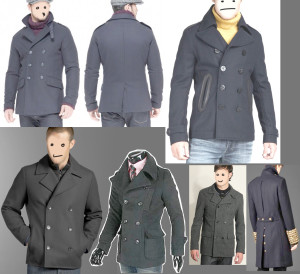
Harry's coat reference
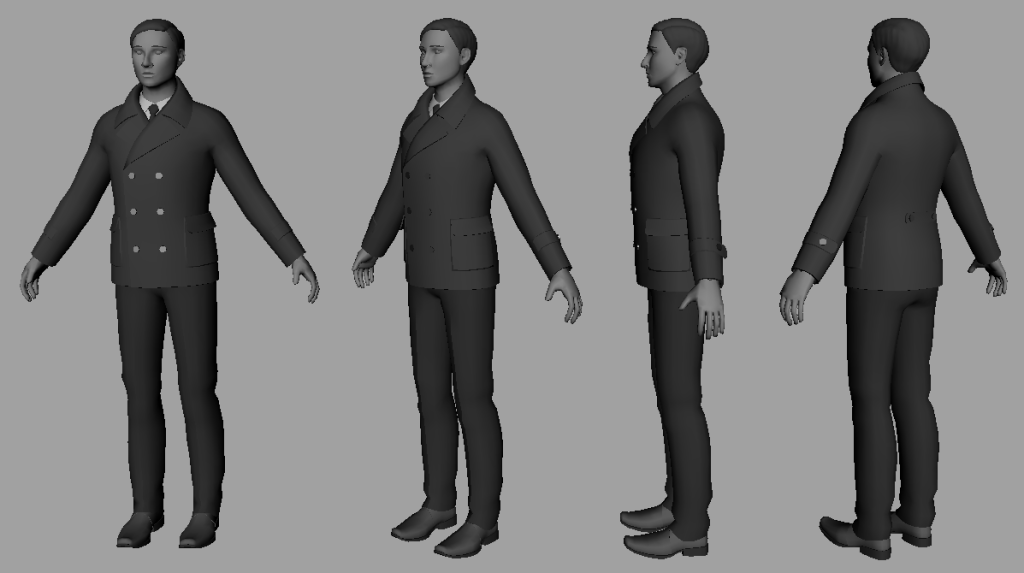
Harry progress shot
When working on Sarah we realised that having a solid mesh for hair, as with Harry and Will, did not achieve the look we were going for. The hair took us several attempts to arrive at a solution that looked acceptable. Some of the hair solutions we tried looked amazing but were difficult to modify for the character fading effect we use. Here is an internal development video discussing some of the fading effects for objects and characters. It shows how the popping of the hair was a problem.
Ultimately we used Unity's Standard Shader to do the hair in combination with alpha maps to get the consistent look and fade effect that we were after.
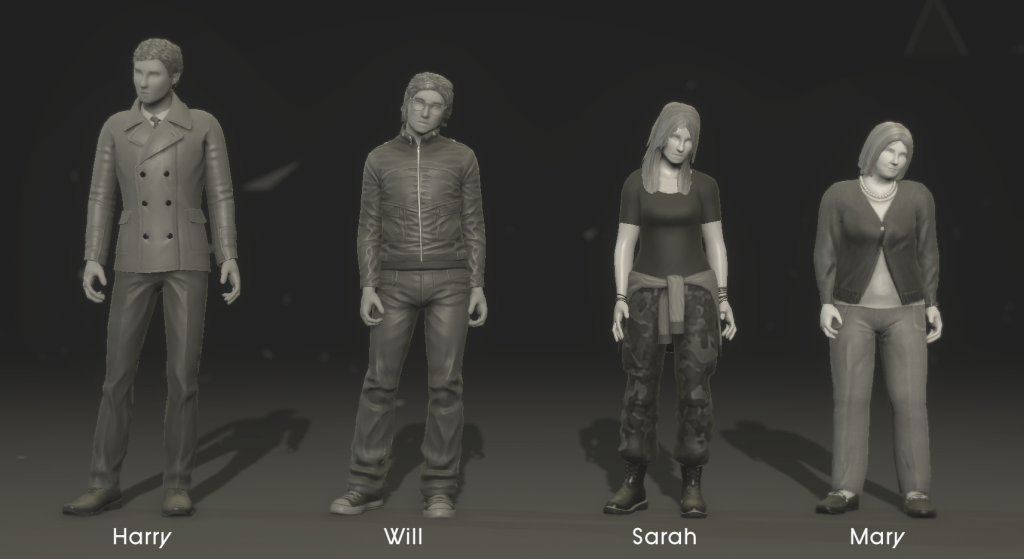
The main cast of Fragments of Him
Many months and iterations later we arrived at the current cast that you see below consisting out of many different outfits for the various points that make up the story.
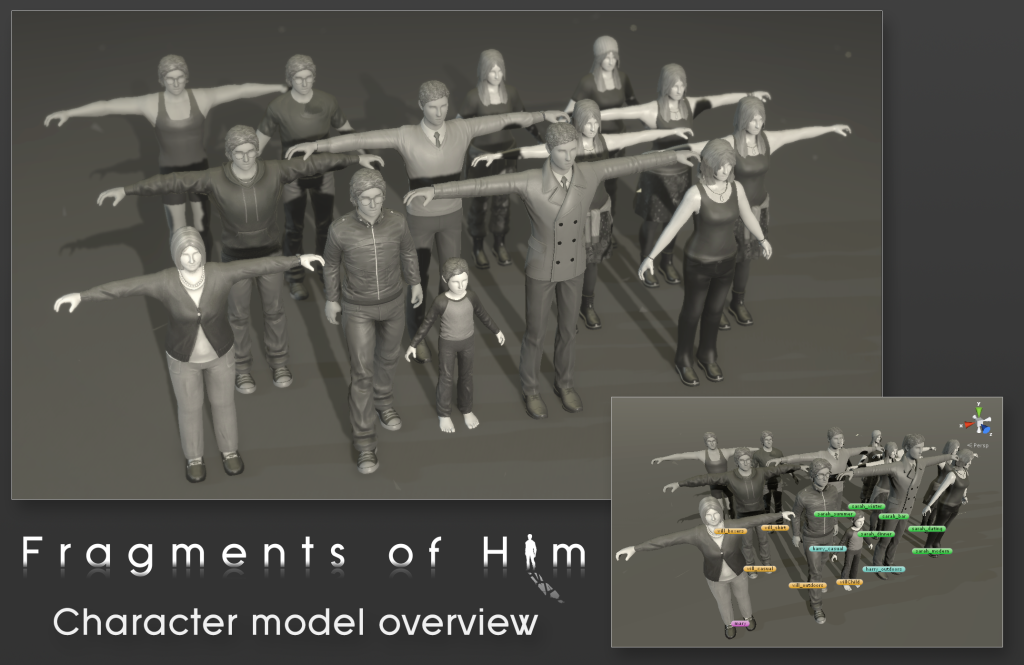
Filler characters
Earlier in this blog I mentioned that some of the scenes that Mata needed to tell the story were in public areas that needed crowds of people. Considering the already difficult task of developing the main cast, we also had to consider how we were going to fill public spaces with nondescript characters. Our cast overview looked a bit like this:
Main cast: Will, Harry, Sarah, Mary
Support cast: Will's parents, Sarah's parents
Filler cast for: the city, park, bar, campus, cinema, etc
The main cast combined has around 15 different models that make up all the different outfits. It was important that the support cast had to be distinct and yet nondescript, and the filler cast could be nondescript but should fit the context of the scene. For the support and filler cast our main challenge was to create animated characters that fill space, are sometimes distinct, and yet don't draw too much attention due to their lack of detail and non-essential role in the story. This lead to experiments on how to shade these characters in a way that:
does not require any uv-unwrapping.
shows a nice silhouette.
hides the low polygonal detail.
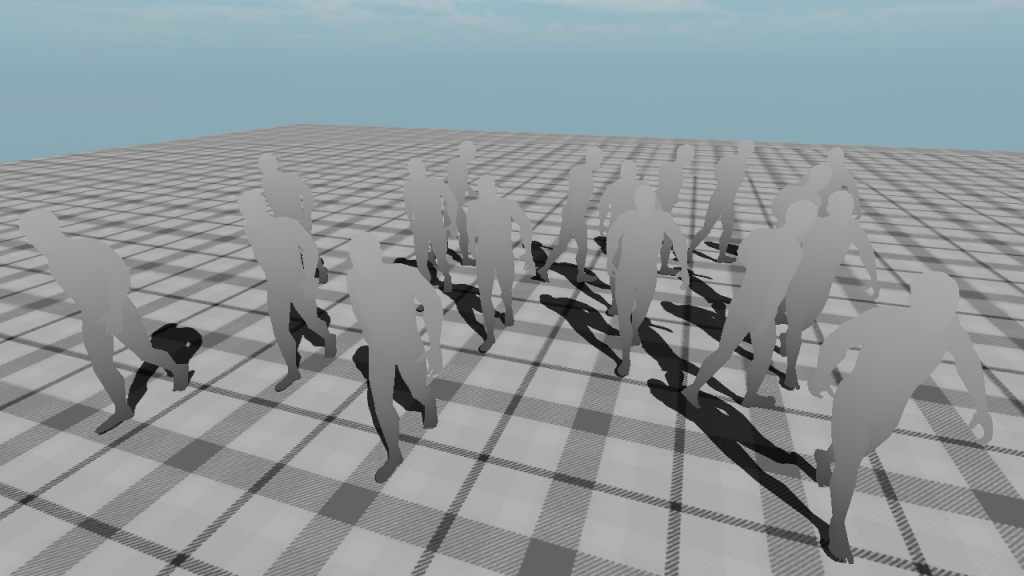
Filler character experiment
At several points in the st






































